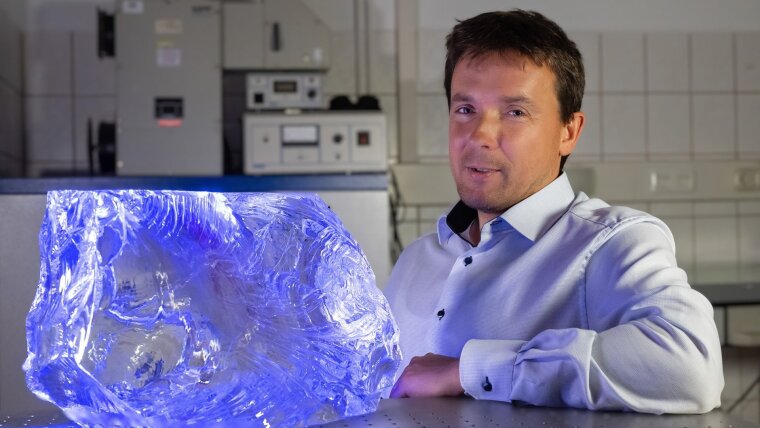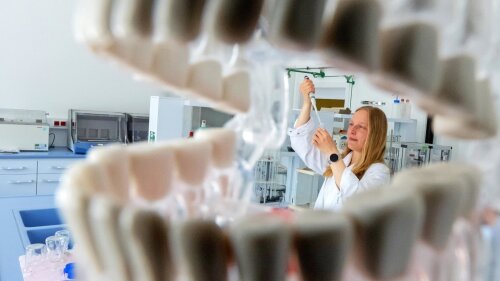
The United Nations (UN) has declared 2022 the International Year of Glass. Lothar Wondraczek, a glass chemist at the University of Jena, is part of the central organization team for the themed year. In this interview, he explains why the ancient material deserves more attention and how glass can help us live more sustainably.
Interview by Ute Schönfelder
Mr Wondraczek, why has the UN declared 2022 the International Year of Glass?
The primary motivation is to generate awareness for the ubiquitous role of glass in human history, culture and modern technology. Glass innovations have repeatedly led to transformative societal advances, including the first tools made from obsidian, glass containers for storing food or pharmaceuticals, and window panes that enabled building interiors which became both warm and bright. These and many other glass products have fundamentally changed the way we live and are continuing to do so.
Discoveries have been made thanks to microscopes or telescopes containing optical glass, and our current data networks, communication channels and the internet are ultimately made from optical glass fibres. So, it seems fair to say that we are living in an age of glass; without glass, our everyday live would be radically different. But yet, the prominent role of glass in all its aspects remains hardly visible to most. The themed year is to change that.
What is so special about glass as a material?
Everything and nothing, really. Along with crystals, glass is one of the two most important states that solid materials can assume. The variety of glass-like materials is practically infinite: In addition to everyday items like window panes, bottles and mobile phones, the term »glass« involves all classes of materials in terms of chemical compositions and resulting properties.
What makes glass so special is its internal structure, that is, the way by which the atoms that make up the glassy state are arranged in a spatial network. This arrangement is fundamentally different to that of crystals. Glass is formed from a liquid that becomes increasingly viscous upon cooling. A point is eventually reached at which the movement of the atoms can no longer be observed on human timescales; at this point, a frozen state is achieved – this is what we refer to as »glass«. The glassy state of matter has numerous fascinating, sometimes even metaphorical aspects: disorder, imbalance, chaos, infinity, the interplay of being solid on the one hand, but visually transparent and liquid-like on the other.
Glass has been manufactured and used in many different ways for thousands of years. What can we still discover about it today?
There are actually a surprising number of unanswered questions. First there is the question of the fundamental nature of glass. Why does glass form in the first place? Why is it solid? How can we describe its structural disorder and dynamics in a way that allows us to predict certain properties, as has long been established for crystals? These are some of the basic research questions that are yet to be answered.
And then there is the social significance of glass materials. Many glasses are mass-produced in an energy-intensive process, with very high material throughput. Glass is almost ideally suited to the circular economies of the future – it is an archetypal example for cradle-to-cradle recycling. However, modern glass technology requires completely new ways of thinking in terms of energy consumption, carbon-neutral production, raw materials, and product design.
The International Year of Glass draws attention to the fact that glass will play a vital role when it comes to achieving the UN Sustainable Development Goals (see info box). Can you give an example?
Let us take recycling as an example: glass containers can contain up to 90% of recycled waste glass– and even that can be increased further by appropriately adapting our production technologies and consumer perception.
Other examples can be found in the buildings sector, which is one of the greatest contributors to CO2 emissions across Europe. Here, modern glasses in the form of insulation materials, multiple glazing and »smart windows« are making a very important contribution to achieving our climate goals. It is interesting to note that in this particular field, glass materials cannot and should not be substituted – after all, they themselves could be substitutes for less sustainable materials. For example, future residential buildings could comprise a much larger fraction of recyclable glass (in the form of glazing and insulation materials) and wood.
Does glass have any disadvantages?
Sticking to the topic of sustainability, the comparatively high weight of glass is certainly critical. Glass bottles are heavy, which can have a major impact on the energy balance. In addition, there is the well-known fragility of glass, which will require a lot of research and development work to overcome in the future.
Of course, there are also fundamental properties resulting directly from the nature of glass and its structural disorder. Compared to crystalline materials, structural disorder can have a negative impact on optical properties, in particular, in what is known as »optical activity«. This can be partially offset by fabricating glass in the form of long fibres, which enable an increased interaction length between light and material in optical applications.
Are there any areas of life where glass is found but you don’t really notice?
Yes, absolutely. Strictly speaking, PET bottles are also made of glass. Many variants of plastics are actually frozen-in, supercooled liquids, by definition, glasses. More obviously, fine glass particles can also be found in cosmetics, toothpaste and many other household products, or can even be added to drinking water so as to help keeping pipes free of deposits. Finally, glass plays a central role in almost any electrical appliance.
What is Jena’s role in glass research and the International Year of Glass?
Jena is one of the global centres of academic glass research – not only through the university, but also thanks to the large number of local research institutions in the field of optics and photonics. In addition, the local landscape is dotted with industrial research institutions of different shapes and sizes.
Jena’s researchers have been involved in numerous activities as part of the International Year of Glass: Having drafted the programme for the UN opening ceremony in Geneva, they will also be coordinating the world’s largest glass congress in Berlin and attending the closing event in Tokyo.
We’ve just launched a junior researcher programme to sponsor young talent identified as »Glass Future Fellows«. Around 70% of them are young women. In autumn, we’ll be hosting the 10th Otto Schott Colloquium, a high-ranking academic conference at our university with guests from all over the world. We’re also trying to raise general awareness about glass by organizing various events in cooperation with schools and museums.
What questions about glass are you hoping to answer yourself through your work?
My research group is currently working on three core topics. Firstly, the mechanical properties of glass materials, e.g., how glass can be made thinner without losing its mechanical resistance. We’re also dealing with the targeted configuration of certain optical properties of glass such as light refraction and optical activity, e.g., in the form of fluorescence. This is related to our third field of work: the search for new and unusual ways of producing glass. These include gas-phase and solution-based methods, as well as high-pressure synthesis and alternative melting processes that enable the production of novel glass materials and could even give rise to more energy-efficient and sustainable technologies in the future.
International Year of Glass »IYOG«
The United Nations (UN) have declared 2022 the »International Year of Glass« (IYOG) to raise awareness of the significant contribution this material has made over several millennia of human history and the important role it will continue to play in the future.
It is impossible to imagine the modern world without glass. And the immense challenges of the future cannot be overcome without this material, which stands for innovation and transformation like no other. The aim of the »IYOG« is to highlight the important role to be played by glass when it comes to achieving the 17 Sustainable Development Goals (SDGs) included in the UN’s 2030 Agenda. Here is a selection of those goals:
